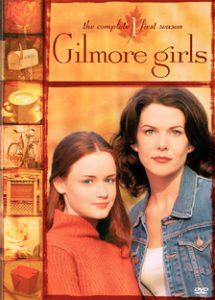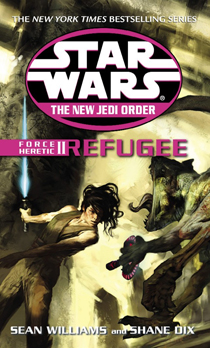“Force Heretic II: Refugee” (2003) is one of the most enjoyable page-turners of the “New Jedi Order,” and it’s also the book that has the least to do with the main plot of the “NJO.” The second of a trilogy by Sean Williams and Shane Dix and the 16th book in the series, “Refugee” is split into three storylines like its predecessor, “Remnant,” and the best of those three is essentially a sequel to “The Truce at Bakura.” The second-best plotline chronicles our heroes’ “Foundation and Earth”-style search for Zonama Sekot. The third plotline is more forgettable, but it also takes up the fewest pages: Nom Anor continues to spark an uprising among Yuuzhan Vong Shamed Ones.
In this trilogy, Williams and Dix have shown interest in digging into the two species that were proto-Yuuzhan Vong: aliens from outside the galaxy (or a hidden part of the galaxy) who have morals that seem abhorrent to us. In “Remnant,” Williams and Dix sent Leia, Han, Jaina, Jag and Tahiri to the Koornacht Cluster, where they discover the Yevetha have been wiped out by the Vong; however, that book was hardly a full-fledged follow-up to the “Black Fleet Crisis” trilogy. It was just a way to re-emphasize how threatening the Vong are, even as the “NJO” builds toward what we know will be a Galactic Alliance victory in book 19.
“Refugee,” on the other hand, delves deeply into the politics and situations of Bakura as our heroes stop by as part of their ongoing mission to check in on planets where communications have been cut off. The P’w’eck – the Ssi-ruuk’s slave race – want to sign a military treaty with the Bakurans against the Ssi-ruuk. The authors portray the political machinations with an ominous tone, and it builds to a nice surprise (which does involve the Vong after all; those ooglith masquers sure come in handy when you need a narrative twist).
The Ssi-ruuk are still a threat, thanks in part to their alliance with Bakura’s Prime Minister Cundertol, who turns out to be a Human Replica Droid. Hats off to the authors – who are obviously well-versed in the Expanded Universe and not merely reference-dropping – for tying in HRDs (first introduced in “Shadows of the Empire,” via Guri) with the Ssi-ruuk’s entechment technology, whereby sentient brains are transferred into machines.
Williams and Dix smartly clear up a confusing point from the “Corellian Trilogy.” In those books, it seems like the New Republic calls upon the Bakuran navy, which is odd because the New Republic should have a massive military of its own. But “Refugee” explains that the New Republic in fact gave this navy to Bakura to defend against the Ssi-ruuk in the wake of “The Truce at Bakura.” So while it technically belongs to Bakura, the idea of the New Republic asking for help was not politically out of proportion.

Tahiri’s arc gets good in “Refugee.” Essentially, this is a split-personality story, as Tahiri has shared her body and mind with Riina Kwaad ever since her aborted shaping on Yavin IV in the “Edge of Victory” duology. Riina has really asserted herself since Tahiri became wracked with grief upon Anakin’s death in “Star by Star.” While this is a standard sci-fi/fantasy character arc in some ways, I like Tahiri and root for her. She’s an original spirit – she eschews wearing shoes, for instance – and hearing her refer to Han and Leia as “Anakin’s parents” is particularly endearing.
In the second thread, Luke, Mara, Jacen, Danni, Saba and Tekli continue their search for Zonama Sekot, following the late Vergere’s assertion that the rogue planet will play a crucial role in the war. For the first time, we visit Csilla, the Chiss home planet. It’s a ball of ice, like Hoth, but the Chiss live in tunneled-out cities under the surface. This feels very Lucasian to me – a planet that at first glance isn’t a logical place for a civilization, yet there is a certain logic to it: The Chiss chose Csilla as a capital as a way to prove their toughness. Also, it’s naturally fortified against attack.
A gem of Csilla is the Chiss library, where our heroes search for Zonama Sekot in a sort of extended version of Obi-Wan’s search for Kamino in 2002’s “Attack of the Clones” – except the Chiss, for all the technological prowess necessary to make Csilla habitable, prefer old-fashioned books to a computer database. As such, Jacen and company make like “Buffy’s” Scooby Gang and spread tomes all over long study tables.
“Refugee” brings us up to speed with Jag’s father, Baron Soontir Fel, a Palpatine-Imperial-turned-Chiss-Imperial who warms up to Luke and company, realizing they have similar values and a common enemy. And we meet the precocious teenager Wynssa Fel — the daughter of Soontir Fel and Syal Antilles, and the sister of Jag – who helps Jacen with the research. She seems like a character destined for future stories, but alas, Wookieepedia tells me this is her only appearance. I had somewhat confused her with her cousin, Myri Antilles, a future member of Wraith Squadron. I’m also happy that Syal gets a lot of page-time, although it still irks me that her kidnapping plot from the canceled “X-wing” comics never got properly told.
The Jacen-Danni relationship continues to spark here as Danni explains to Jacen that her feelings for him have grown since they’ve gotten to know each other better. It’s blatant wish-fulfillment for the hopeless romantics among the readership, but at least Danni explains how her feelings changed; if Padme had given a similar monologue in “Attack of the Clones,” it might’ve helped that love story. I had largely forgotten about the Jacen-Danni relationship, but now I’m remembering how it goes bad in “Legacy of the Force,” making this re-read bittersweet. I also must remark that it’s somewhat odd the romance part of his brain never goes to Tenel Ka at this point in the narrative.
On the subject of both romance and the authors’ ability to smoothly reference past events from the saga, here’s a great Leia line from page 388: “Han, we had our first kiss in the belly of a space slug.” I’d never really thought of it that way, but yes indeed, that’s what happened. And it’s totally something Leia would say when being self-deprecating about her romantic life in a time of war.
“Refugee” features even fewer space battles and fight scenes than “Remnant,” and Wookieepedia points out that it’s the only “NJO” book without a single battle against the Yuuzhan Vong. And I’m not sure who the “refugee” of the title is – Riina? Nom Anor? Zonama Sekot? But the novel is effortlessly and deeply “Star Wars-y,” and a joy to read.

